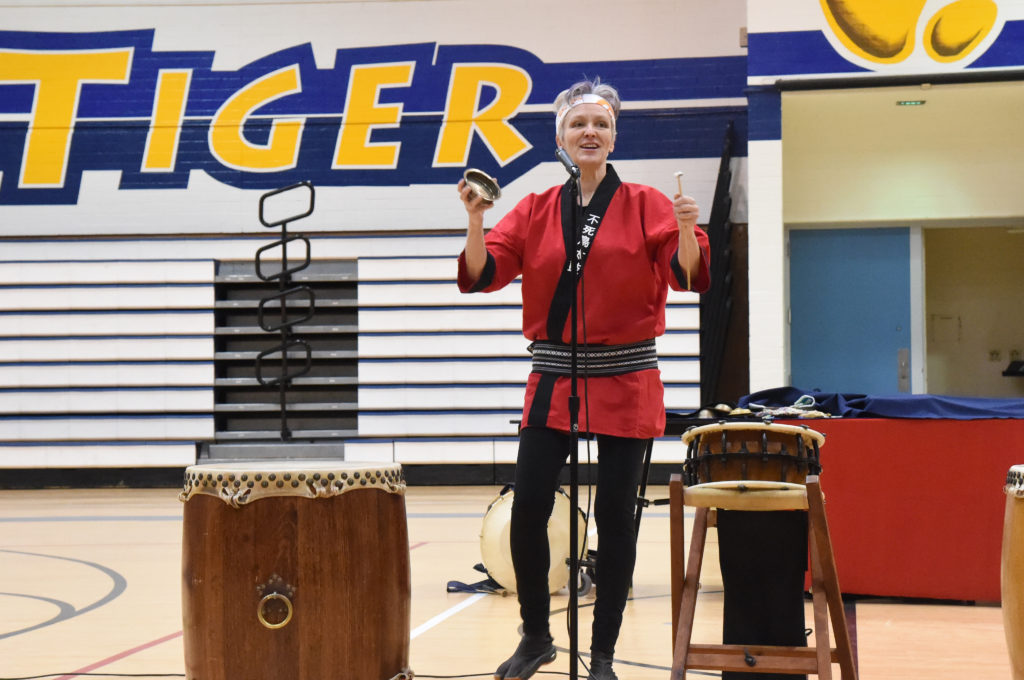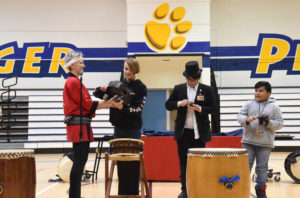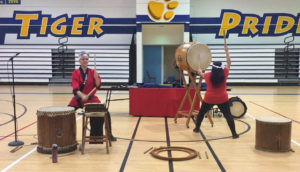
By Robyn Martinez
Did the globe-savvy kids at Tempe Academy of International Studies think they’d ever be carried on an educational magic carpet to a Japanese rainforest? Actually, no. But a surprise visit from a Taiko drum ensemble made them aware that virtual reality can be as near as their Tempe classroom.
Taiko is the Japanese word for great drum, and its history dates back centuries to the time it was an ancient musical art form.
The ancient sounds originated centuries in Asia, where the resounding beat of the massive drums, ranging from one to six feet in diameter, could be heard over great distances and historically was used as a means of communication.
Late last month, kids at the school, part of the Tempe Elementary district, had a special visit from Fushicho Daiko Dojo, a Taiko Japanese drum ensemble. The two performers were Eileen Morgan, owner and lead instructor of the group, and sixth-grade language arts teacher Lise Spangenthal.
While the unique sounds may have been new to the kids, it had a familiar ring to those who brought the program to the school.
This is Spangenthal’s third year studying and performing with Morgan.
 As part of a special assembly, Tempe Academy students were able to take part in the unique experience, watching the performers, dressed in Happi coats and two-fingered Tabi shoes—authentic Japanese Taiko attire—as they performed on Japanese drums, most handmade by Morgan herself, as well as on carved wooden frog-shaped instruments called Guiro, which croaked like frogs when played.
As part of a special assembly, Tempe Academy students were able to take part in the unique experience, watching the performers, dressed in Happi coats and two-fingered Tabi shoes—authentic Japanese Taiko attire—as they performed on Japanese drums, most handmade by Morgan herself, as well as on carved wooden frog-shaped instruments called Guiro, which croaked like frogs when played.
The Guiro all had varying pitches, depending on their size, with the largest ones croaking the lowest and the smallest ones almost chirping.
When all were played simultaneously, it sounded like a rain forest, observed one of the youngsters.
Morgan demonstrated the difference in sound between Japanese and Chinese cymbals, explained how the Japanese bow to their instruments before they play, and spent time explaining the importance of respect to the spirit of the instrument to students.
Morgan also chanted certain words which indicated how the performer should play the drum or tap the drumsticks, ending with some students and their teachers having a chance to play the instruments themselves.
“Tempe Academy is an International Baccalaureate school, and studying world cultures is part of our curriculum,” said Spangenthal. “I think it’s important for our students to learn about non-Western cultures and integrate that into our music classes.”
 In its early days, the kids learned, Taiko could be used to signal distant villages, such as to warn of the approach of an advancing enemy or an impending disaster or to signal troops on the battlefield. In shrines and temples throughout present-day Japan, Taiko can still be heard, although now its purpose is more spiritual and celebratory, often occasioned by village festivals.
In its early days, the kids learned, Taiko could be used to signal distant villages, such as to warn of the approach of an advancing enemy or an impending disaster or to signal troops on the battlefield. In shrines and temples throughout present-day Japan, Taiko can still be heard, although now its purpose is more spiritual and celebratory, often occasioned by village festivals.
Only in the last 60 years in Japan and approximately the last 45 years in North America has Taiko evolved into a powerful performing art.
The Fushicho Daiko Dojo will be performing for the general public soon at Arizona Matsuri, an annual festival celebrating Japanese culture and heritage at Heritage Square in downtown Phoenix on Feb. 23 and 24.
Information: (Instagram) @taikoarizona; (Facebook) @ taikoaz; or (website) taikoaz.com.

